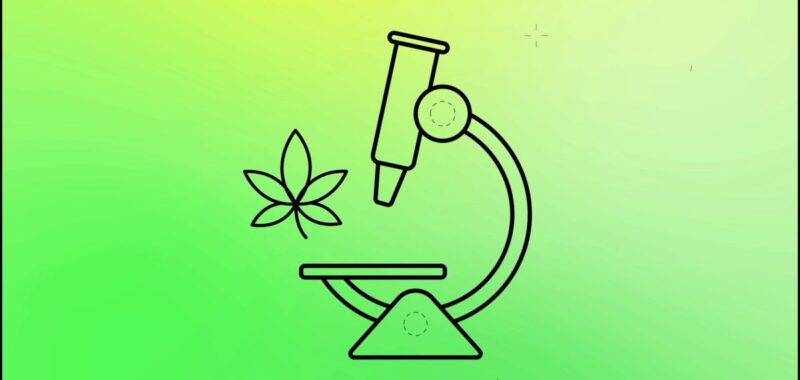Marijuana contains more than 500 active compounds. But most people focus on two: There’s cannabidiol, or CBD, which reduces inflammation.
And then there’s THC, which is the main psychoactive component—it’s the reason weed gives you the relaxed and “euphoric” sensation of being high.
THC stands for tetrahydrocannabinol. It’s a compound that comes from the flowers of female cannabis plants, though there’s some in other parts of the plant, too.
On supporting science journalism
If you’re enjoying this article, consider supporting our award-winning journalism by subscribing. By purchasing a subscription you are helping to ensure the future of impactful stories about the discoveries and ideas shaping our world today.
In raw cannabis, most THC is in the form of tetrahydrocannabinolic acid, or THCA. That means the molecules contain an extra acid group.
THCA won’t get you high. But you convert THCA to THC by heating weed, vaporizing it or exposing it to sunlight.
When you consume cannabis by smoking, vaping, dabbing or eating “edibles”, THC enters your bloodstream.
From there, it crosses the blood-brain barrier and binds to cannabinoid receptorsin brain regions that control memory, appetite, fear and motor control.
The compound blocks short-term memory, altering your perception of time.
It tells your brain you’re hungry, and makes food smell and taste better. It also triggers the release of dopamine, creating intense feelings of pleasure.
Ancient Chinese and South Asian people used cannabis as medicine for thousands of years.
Ancient Romans used it to cure earaches. In Africa, it was used to alleviate childbirth pain and treat malaria.
The plant was also used to make paper in China and the Middle East, and Muslims introduced the process to Europe.
Over several centuries, this led to two different versions of the same plant: one that was bred for high THC and one that was bred for industrial purposes.
In the 1830s Irish doctor William O’Shaughnessy learned about medicinal cannabis while teaching in India.
O’Shaughnessy started using it to treat muscle spasms and cholera, and he reported his success to Western researchers who quickly began using it on everything from coughing to pain to gonorrhea.
By the early 1900s, Americans were familiar with cannabis.
But in the mid-1800s, the Mexican press started reporting on “marihuana” (spelled with an “h” or a “g”), a drug that was allegedly making people become mentally ill and violent.
It’s unclear what actually caused the highly publicized incidents.
But Mexico outlawed the drug in 1920. In the U.S. Congress followed suit, effectively making marihuana illegal in 1937 by imposing huge taxes on it, and states criminalized selling or possessing it.
In 1970 the Controlled Substances Act designated “marijuana” (which had come to be spelled with a “j” in the U.S.) as a Schedule I illegal drug, alongside heroin.
That designation has always been controversial.
As early as 1972, experts recommended decriminalizing marijuana based on new studies that showed it wasn’t addictive, harmful or a stepping stone to worse drugs.
But President Richard Nixon refused.
THC does have some risks.
As a psychoactive compound, high doses of THC can fuel panic attacks and paranoid thoughts.
It can worsen mental health issues for people with a genetic predisposition for schizophrenia. And because THC impairs motor function, driving while high is dangerous.
But for most people, a moderate amount of THC is safe and often helpful. It can relieve nausea.
It can also help with anxiety, insomnia, pain, and muscle spasms, though CBD is more effective for some of those issues.
There’s a lot we still don’t know about weed, though, because of restrictions on studying it.
Starting in 1974, to study marijuana, researchers had to obtain it through the National Institute on Drug Abuse, or NIDA, which has mostly supported studies focused on the drug’s harms.
Also, NIDA’s marijuana is low in THC and often low-quality, making it ineffective for studying what’s actually on the market.
But we’re about to get much more research on the drug.
In 2022 President Joe Biden signed a bill allowing more institutions and private companies to grow and handle cannabis for research purposes.
Among the things scientists hope to study are different types of THC.
While they’ve historically focused on delta-9-tetrahydrocannabinol, isomers of the compound have recently started hitting the market—essentially, these are versions of THC with subtle differences in their chemical structures.
Delta-8-THC and delta-10-THC, for instance, are milder cannabinoids found in hemp cannabis. But research on them is very preliminary, and some states have already taken moves to ban them.
Researchers hope that fewer restrictions will allow them to bring science on marijuana up to speed with the way people are actually using it.
And it should give us all a much better idea of THC’s specific medical benefits—and how to find more applications for its use.

